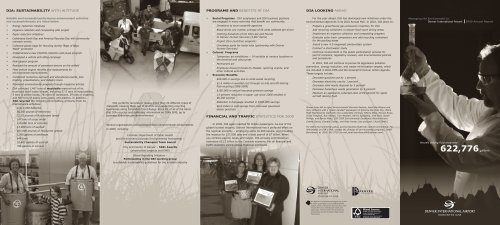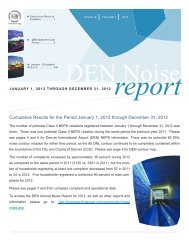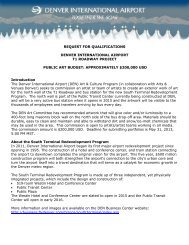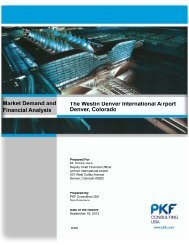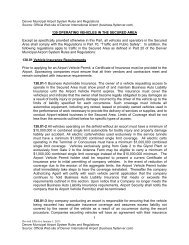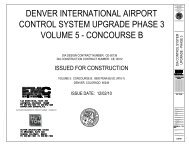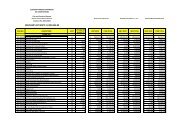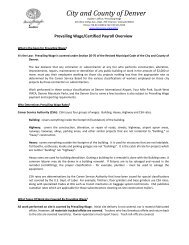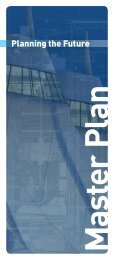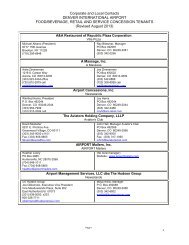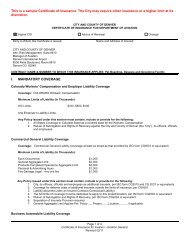2009 Annual Report - Denver International Airport
2009 Annual Report - Denver International Airport
2009 Annual Report - Denver International Airport
Create successful ePaper yourself
Turn your PDF publications into a flip-book with our unique Google optimized e-Paper software.
DIA: Sustainability with altitude Programs and benefits at dia DIA Looking Ahead<br />
Notable environmental performance enhancement activities<br />
and accomplishments are listed below.<br />
<br />
Social Programs - DIA employees and DIA business partners<br />
are engaged in many activities that benefit our community.<br />
For the year ahead, DIA has developed new initiatives under the<br />
environmental objectives in its 2010 <strong>Annual</strong> Plan. In 2010, DIA plans to:<br />
Managing the Environment at<br />
<strong>Denver</strong> <strong>International</strong> <strong>Airport</strong><br />
<strong>2009</strong> <strong>Annual</strong> <strong>Report</strong><br />
<br />
Energy-reduction initiatives<br />
Donations to local nonprofit agencies<br />
<br />
Prepare a greenhouse gas-emissions inventory for DIA<br />
<br />
<br />
<br />
<br />
<br />
<br />
<br />
<br />
<br />
<br />
<br />
<br />
Organics collection and composting pilot project<br />
Paper-reduction initiatives<br />
Celebrated Earth Day and America Recycles Day with community<br />
outreach events<br />
Collected plastic bags for recycling during "Bags of Bags<br />
Week" promotion<br />
Implemented a new CD/DVD collection and reuse program<br />
Developed a vehicle anti-idling campaign<br />
New carpool program<br />
Reduced the amount of pavement deicers on the airfield<br />
Fleet vehicle engine retrofits and replacements for<br />
environmental improvements<br />
Conducted numerous outreach and educational events, plus<br />
training, presentations, and industry tours<br />
Promoted environmental program through magazine articles<br />
DIA collected 1,467 tons of recyclable material out of its<br />
municipal solid waste stream, including 57.5 tons of wood pallets,<br />
3 tons of phone books, 781 tons of cardboard, 39 tons of organics,<br />
and 587 tons of paper, cans, glass, and plastics. In addition,<br />
DIA recycled the following commodities, primarily from its<br />
maintenance activities:<br />
over 4,000 batteries<br />
56,360 pounds of electronics<br />
7,135 pounds of fluorescent lamps<br />
147 tons of scrap metal<br />
115,000 tons of concrete<br />
13,900 tons of asphalt<br />
107,000 pounds of restaurant grease<br />
1,700 gallons of antifreeze<br />
644 tires<br />
18,643 gallons of used oil<br />
796 gallons of solvent<br />
DIA currently recycles or reuses more than 20 different types of<br />
materials, keeping them out of landfills and supporting recycling<br />
businesses along Colorado’s Front Range. For a list of all of the items<br />
that DIA recycles and additional information on DIA’s EMS, go to<br />
business.flydenver.com/environmental.<br />
Several organizations acknowledged DIA’s environmental achievements<br />
in <strong>2009</strong>, including:<br />
Colorado Department of Public Health<br />
and Environment/Colorado Environmental Partnership –<br />
Sustainability Champion Team Award<br />
City and County of <strong>Denver</strong> – 5281 Awards<br />
(photovoltaic projects and EMS)<br />
<br />
<br />
Blood drives (six events; average of 55 units collected per drive)<br />
Clothing donations (from DIA Lost and Found)<br />
to <strong>Denver</strong> Human Services (3,867 items)<br />
Project Zero (nutrition program)<br />
Christmas party for foster kids (partnering with <strong>Denver</strong><br />
Human Services)<br />
Cultural Programs<br />
Temporary art exhibitions – 14 exhibits at various locations in<br />
the terminal and concourses<br />
Permanent art<br />
Employee discount tickets to theater, sporting events, and<br />
other cultural activities<br />
Economic Benefits<br />
$95,000 in savings due to solid-waste recycling<br />
$1.4 million in avoided cost through on-site aircraft deicing<br />
fluid recycling (2008-<strong>2009</strong>)<br />
$150,000 in annual insurance premium savings<br />
13-percent reduction in paper use since 2008 resulted in<br />
$6,200 savings<br />
Reduction in fuel usage resulted in $500,000 savings<br />
$6.8 million in cost savings from improved pavement<br />
deicer practices<br />
Financial and Traffic Statistics for <strong>2009</strong><br />
In <strong>2009</strong>, DIA again reached 50 million passengers. As one of the<br />
globe’s busiest airports, <strong>Denver</strong> <strong>International</strong> has a profound effect on<br />
the regional economy – employing some 30,000 people, and providing<br />
the impetus for 217,000 jobs and a total payroll of $7 billion. When<br />
you combine payroll, taxes, and output, DIA annually contributes an<br />
estimated $22.3 billion to the Colorado economy. For all financial and<br />
traffic statistics visit business.flydenver.com/stats.<br />
<br />
<br />
<br />
<br />
<br />
<br />
Add recycling containers in airport food-court dining areas<br />
Implement an organics collection and composting program<br />
Evaluate solar trash compactors and add recycling containers<br />
for the parking areas<br />
Install a new 4.3-megawatt photovoltaic system<br />
Conduct a stormwater study<br />
Continue involvement in the public participation process for<br />
permit revisions, regulatory reviews, and environmental policies<br />
and procedures<br />
In 2010, DIA will continue to pursue its aggressive pollutionprevention,<br />
energy-reduction, and waste-minimization targets, which<br />
are included in DIA’s EMS and the Greenprint <strong>Denver</strong> Action Agenda.<br />
These targets include:<br />
Decrease gasoline use by 1 percent<br />
Decrease electricity use by 1 percent<br />
Decrease solid waste disposal by 5 percent<br />
Decrease hazardous waste generation by 5 percent<br />
Maintain an applied-to-collected ratio of 69 percent for spent<br />
aircraft deicing fluid<br />
Photos from left to right: Environmental Services Section, Janell Barrilleaux and<br />
Jerry Williams with a “green-handed” passenger on America Recycles Day; DIA’s<br />
Fleet Maintenance staff with new sustainable vehicles, Tiffany Dietz, Manuel Rivas,<br />
Scott Trengove, Roy Sexton, Tom Neubert, Danny Spaulding, Jose Solis, Isaiah<br />
Phillips, and Bernie Maez; DIA <strong>2009</strong> Environmental Excellence Award winners<br />
Celena Garcia, Claudia Chavez, and Petie Horton (not pictured: Chuck Smith).<br />
For DIA’s environmental policy, access business.flydenver.com/environmental. For<br />
information on DIA’s EMS, contact the director of environmental programs, Janell<br />
Barrilleaux, at (303) 342-2730 (e-mail janell.barrilleaux@flydenver.com).<br />
Aircraft deicing fluid reclaimed<br />
622,776 gallons<br />
Global <strong>Report</strong>ing Initiative –<br />
Participating in the GRI working group<br />
to establish sustainability guidelines for the aviation industry<br />
The <strong>2009</strong> Environmental <strong>Annual</strong> <strong>Report</strong> was printed<br />
on Forest Stewardship Council-certified Mohawk<br />
Options, which is 100-percent post-consumer waste<br />
recycled fiber and is manufactured entirely with<br />
wind energy. The inks used in this brochure are<br />
linseed-based and are recyclable. Please recycle<br />
this brochure.
Message from the<br />
manager of aviation<br />
I<br />
n <strong>2009</strong>, we developed the DIA Strategic Plan. This<br />
plan represents the culmination of the ideas generated<br />
through broad stakeholder engagement involving city<br />
employees, community leaders, and DIA’s business<br />
partners to make DIA the best airport in the world.<br />
Environmental<br />
management system (EMS)<br />
DIA is the only international airport in the United States that<br />
has designed and implemented an ISO 14001-certified EMS that<br />
encompasses the entire airport.<br />
Originally certified in 2004, DIA’s EMS is a mature system that<br />
provides a framework for the airport to identify, prioritize, and manage<br />
aspects of its operation that could impact the environment. DIA’s<br />
<strong>2009</strong> Environmental<br />
Performance <strong>Report</strong> Card<br />
In 2005, DIA set aggressive annual targets for decreasing gasoline<br />
and electricity usage, reducing solid and hazardous wastes, and for<br />
glycol recycling. DIA’s progress toward these targets is illustrated below.<br />
Target: Decrease by 1 percent the gallons of gasoline used per<br />
gasoline vehicle per year.<br />
Metric = gallons gasoline/year/gasoline vehicle<br />
<strong>2009</strong> Solid Waste and Recycling<br />
n Solid Waste to Landfill<br />
(10,857.30 tons)<br />
n Solid Waste to Recycling<br />
(1,467.22 tons)<br />
88%<br />
12%<br />
The plan was published on www.flydenver.com in<br />
<strong>2009</strong>, and since that time, DIA has been developing<br />
performance metrics and implementation plans for<br />
our five strategic priorities:<br />
Excelling in airport management<br />
Providing unparalleled, inspiring service<br />
Taking environmental stewardship to new heights<br />
Delivering via high-performance teams<br />
Enhancing our competitive advantage<br />
To synchronize DIA’s Environmental Management<br />
System with the strategic plan, I have made revisions<br />
to the airport’s environmental policy that I believe<br />
strengthen the link to the strategic plan and our<br />
commitments to environmental compliance and<br />
sustainability. It is with great pleasure and pride that I<br />
introduce the revised DIA Environmental Policy as part<br />
of DIA’s <strong>2009</strong> Environmental <strong>Annual</strong> <strong>Report</strong>.<br />
We invite you to review our revised policy as well<br />
as the environmental results contained in this report.<br />
And we welcome your comments and suggestions on<br />
how we can continue to improve our performance.<br />
Kim Day<br />
Manager of Aviation<br />
DIA Environmental Policy:<br />
business.flydenver.com/environmental<br />
EMS focuses on developing and implementing programs to address<br />
potential impacts from significant environmental aspects. For a list<br />
of DIA’s significant environmental aspects, go to the environmental<br />
section on DIA’s Web site business.flydenver.com/environmental and<br />
click on the link.<br />
As part of EMS implementation, DIA also identifies and implements<br />
programs and projects to improve environmental performance.<br />
Consistent with the process identified in our EMS, this <strong>2009</strong> report<br />
is designed to educate stakeholders on our progress toward<br />
environmental performance targets, and to communicate our<br />
targets and objectives for 2010.<br />
The annual objectives of DIA’s EMS are:<br />
Improve environmental compliance<br />
Reduce potential liabilities<br />
Enhance the airport’s positive image<br />
Implement a reliable Environmental Management System<br />
Evaluate pollution-prevention, energy-reduction, and<br />
waste-minimization opportunities<br />
DIA continues to pursue these objectives systematically through<br />
its EMS “Plan, Do, Check, Feedback” process.<br />
Management<br />
Review<br />
Checking and<br />
Corrective<br />
Action<br />
Implementation<br />
and Operation<br />
Continual<br />
Improvement<br />
Planning<br />
Environmental<br />
Policy<br />
1000<br />
800<br />
600<br />
400<br />
200<br />
0<br />
2005<br />
n Baseline<br />
n Goal<br />
n Actual<br />
2005<br />
2005<br />
2006<br />
2006<br />
2006<br />
2007<br />
(238,038 gallons/424 vehicles)<br />
2007<br />
2007<br />
2008<br />
(<strong>2009</strong> - 236,280 gallons/367 vehicles)<br />
2008<br />
2008<br />
<strong>2009</strong> 2010<br />
57 percent of DIA's light-duty fleet is alternatively fueled<br />
Target: Decrease by 1 percent the annual kilowatt hours<br />
used per passenger.<br />
Metric = kWh used/year/passenger<br />
6<br />
5<br />
4<br />
3<br />
2<br />
1<br />
0<br />
n Baseline<br />
n Goal<br />
n Actual<br />
561 556<br />
860<br />
550<br />
836<br />
(228,373,418 kWh/43,387,513 passengers)<br />
(<strong>2009</strong> - 229,588,095 kWh/50,167,485 passengers)<br />
<strong>2009</strong> 2010<br />
Target: Decrease pounds of non-hazardous solid waste disposed each<br />
year per passenger by 5 percent.<br />
Metric = pounds of total disposed solid waste/year/passenger<br />
0.6<br />
0.5<br />
0.4<br />
0.3<br />
0.2<br />
0.1<br />
0.0<br />
545<br />
770<br />
644<br />
539<br />
534<br />
5.26 5.21 5.16 5.11 4.85<br />
5.06 5.01<br />
4.35 4.29<br />
4.58<br />
.51<br />
.48 .49<br />
.52<br />
.46 .445 .44<br />
.42 .43<br />
.39<br />
<strong>2009</strong> 2010<br />
Target: Decrease the amount of city-generated hazardous waste by 1<br />
percent annually (note: excludes universal waste).<br />
Metric = pounds/year/million passengers<br />
30<br />
25<br />
20<br />
15<br />
10<br />
5<br />
0<br />
28.16<br />
27 26.7 26.5 26.2 26.0 25.7<br />
2005<br />
n Baseline<br />
n Goal<br />
n Actual<br />
14.5<br />
2006<br />
2007<br />
19.4<br />
2008<br />
(1,175 pounds / 43.4 million passengers)<br />
6.1<br />
<strong>2009</strong><br />
(<strong>2009</strong> - 307 pounds / 50.2 million passengers)<br />
2010<br />
Target: Maintain an aircraft deicing fluid (ADF) applied-to-collected<br />
ratio of 69 percent.<br />
Metric = total gallons of ADF used/gallons captured<br />
Baseline 2004-2005 season = 69 percent. DIA has consistently<br />
maintained an ADF applied-to-collected ratio of 69 or 70 percent.<br />
2008-<strong>2009</strong> Deicing Season<br />
n Total ADF Applied = 1,241,093 gallons<br />
n Total ADF Collected = 868,765 gallons<br />
Of the 70 percent collected:<br />
70%<br />
— 622,776 gallons of ADF were<br />
reclaimed (72 percent)<br />
— 209,187 gallons of ADF were sent to<br />
Metro Wastewater (24 percent)<br />
DIA Environmental Programs<br />
8500 Peña Blvd<br />
<strong>Denver</strong>, CO 80249-6340<br />
On the cover: Richard Langlois, Environmental Services Section<br />
n Baseline<br />
n Goal<br />
n Actual<br />
(10,963 tons / 43,387,513 passengers)<br />
(<strong>2009</strong> - 10,857 tons / 50,167,485 passengers)


